Disclosure: This article contains affiliate links. We may earn a commission from purchases at no extra cost to you, which helps our travel content.
The first time I ventured beyond Lisbon's terracotta rooftops and winding cobblestone streets, I was struck by how quickly Portugal's capital surrenders to the Atlantic's embrace. Having documented textile traditions across four continents, I've developed a habit of seeking connections between urban centers and their surrounding landscapes. Lisbon's relationship with the sea is woven into its very identity—from the haunting fado melodies lamenting sailors lost to distant shores to the intricate maritime motifs adorning the azulejo tiles that blanket the city. Yet surprisingly, many families visiting this vibrant capital never experience the golden coastline that shaped Portuguese history and culture. Within just an hour's journey, seven distinct beaches offer everything from protected coves perfect for little ones to wild stretches where fishermen still haul in catches using techniques passed through generations. This week-long coastal exploration isn't just about finding perfect swimming spots (though there are plenty)—it's about understanding how the sea continues to influence local life in ways both profound and delightfully mundane.
Cascais: Where Fishermen's Traditions Meet Royal History
The train journey from Lisbon's Cais do Sodré station to Cascais offers a cinematic introduction to Portugal's coastline, with the tracks hugging the shoreline so closely that sea spray occasionally mists the windows during stormy days. I've made this 40-minute trip countless times over three separate research visits, and the transition from urban energy to coastal charm never loses its magic.
Cascais itself presents a fascinating cultural juxtaposition—once a humble fishing village, later the preferred summer retreat for Portuguese royalty. This dual identity makes it particularly appealing for families. Children can watch fishermen mending nets in the morning light near the small harbor, while parents appreciate the elegant 19th-century architecture reflecting the town's aristocratic period.
The main Praia da Ribeira sits directly in town, offering gentle waters in a sheltered bay that's ideal for younger swimmers. What fascinates me as an anthropologist is how this beach serves as a community gathering space where generational knowledge transfer happens naturally—I've watched grandparents teaching grandchildren how to prepare fishing hooks using the same hand movements their ancestors employed centuries ago.
For a more immersive experience, walk ten minutes west to Praia da Rainha (Queen's Beach), a tiny cove named for Queen Amélia who selected it as her personal bathing spot in the 1880s. The descent down stone steps rewards you with remarkably clear waters and natural shade from surrounding cliffs—a perfect midday refuge when the summer sun intensifies.
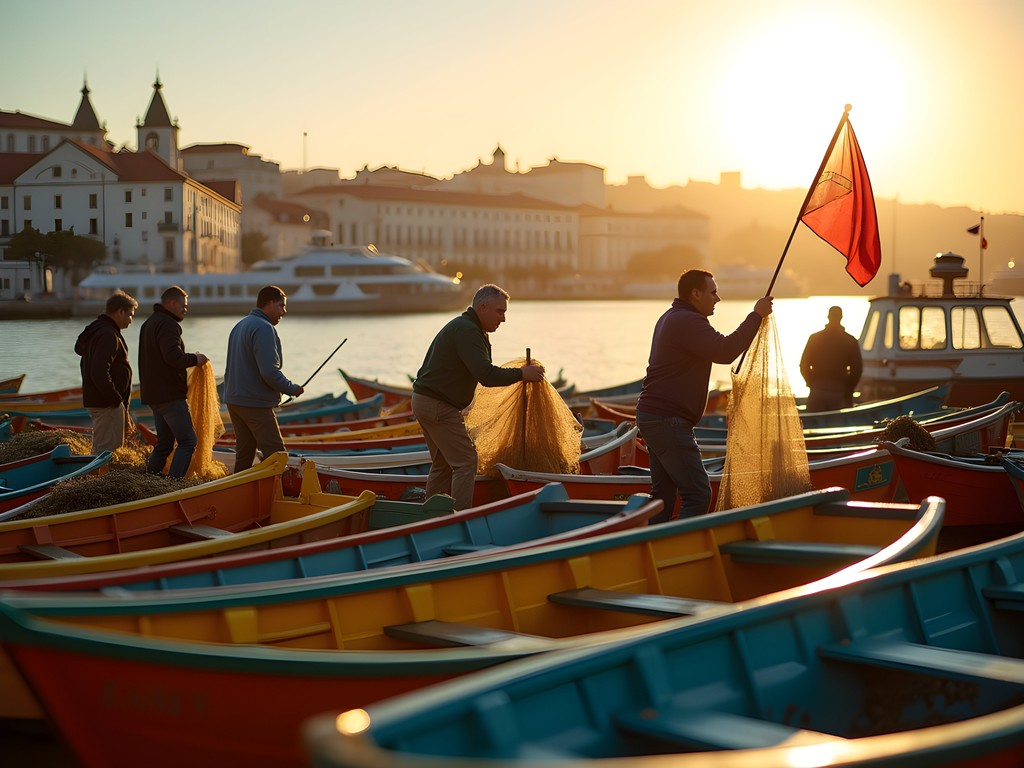
💡 Pro Tips
- Visit the Cascais Marine Life Interpretation Center near the main beach for an educational break—it's free for children under 12
- Pack water shoes for little ones as some areas have rocky entries to the water
- The morning fish auction at the harbor (around 7am) offers a fascinating glimpse into local maritime economy
Costa da Caparica: Endless Golden Shores for Active Families
Crossing the iconic 25 de Abril Bridge toward Costa da Caparica feels like entering another world entirely. While Cascais represents Portugal's more polished coastal offering, this 15km stretch of uninterrupted golden sand on Lisbon's south bank speaks to something more primal and democratic. During my field research on changing leisure patterns in post-revolutionary Portugal, I spent weeks documenting how this coastline serves as the great social equalizer—where factory workers and finance executives spread their towels with equal claim to the Atlantic view.
For families, Costa da Caparica's greatest asset is its versatility. The northern beaches nearest the town offer infrastructure—restaurants, bathrooms, lifeguards, and the charming "comboio de praia" (beach train) that shuttles visitors along the coast during summer months. My beach tent proved invaluable here, creating a shaded base camp for day-long explorations.
As you move southward, the beaches become progressively less crowded and more natural. Praia da Morena and Praia da Sereia offer the perfect balance of accessibility and space—crucial when traveling with energetic children needing room to play. What particularly struck me was watching local families construct elaborate windbreaks using driftwood and colorful scarves, creating temporary territories that reflect the Portuguese talent for making clever use of available resources.
The southern reaches near Fonte da Telha reveal a fascinating intersection of contemporary beach culture with older traditions. Here, fishermen still practice arte xávega, a traditional fishing technique where boats launch directly from the beach and nets are hauled in by hand or with the help of tractors. If you time your visit right (typically early morning), children can witness this collaborative community effort that has remained largely unchanged for centuries—a living maritime heritage more impactful than any museum exhibit.
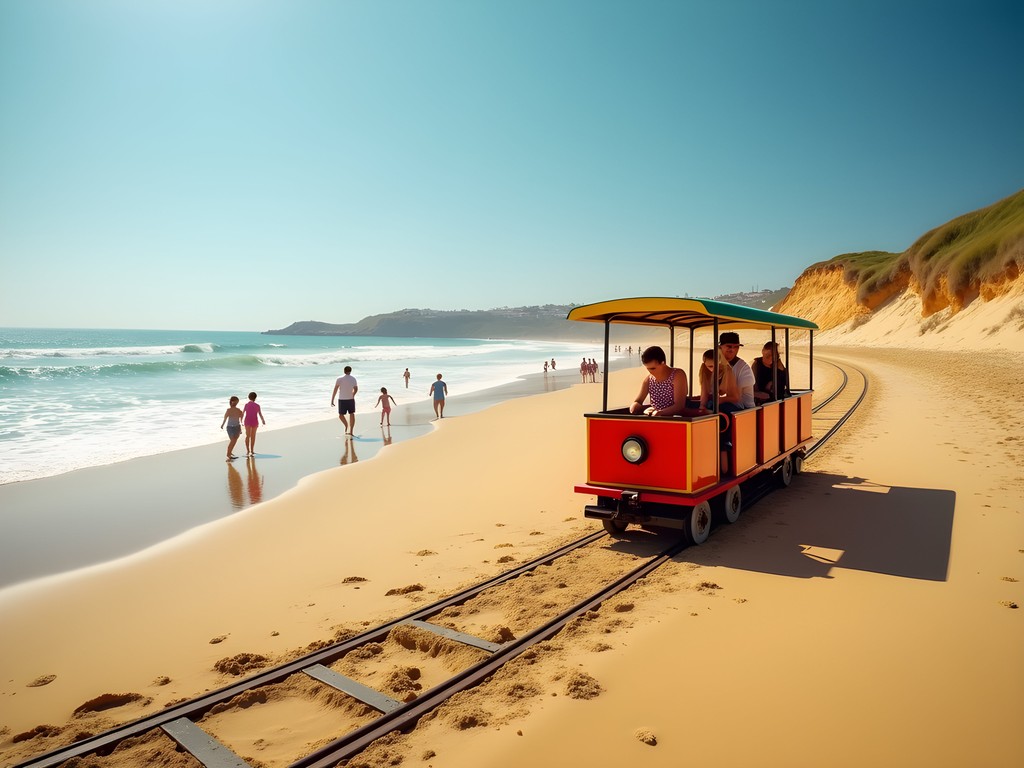
💡 Pro Tips
- Take bus 153 from Praça de Espanha in Lisbon for direct access to Costa da Caparica town
- The beach train (€2.50 for an all-day pass) saves tired little legs from long walks between beaches
- Bring cash for the beachside restaurants as many don't accept cards, especially in the southern sections
Praia do Guincho: Wild Beauty and Cultural Landscapes
The wind hits you first at Guincho—a constant, almost sentient presence that has shaped both the physical landscape and the cultural practices along this dramatic stretch of coast. Located just beyond Cascais in Sintra-Cascais Natural Park, this expansive beach represents a different relationship between humans and the Atlantic—one of respectful challenge rather than gentle coexistence.
During my third visit to Portugal, I spent a week documenting traditional wool processing in mountain villages north of Lisbon. My guide, Maria, insisted we take a day to visit Guincho, explaining that I couldn't understand Portuguese textile traditions without seeing how the maritime environment influenced material culture. Standing on these windswept dunes, watching paragliders harness the same Atlantic currents that once filled the sails of Portuguese caravels, her point became viscerally clear.
For families, Guincho requires a different approach than Lisbon's more sheltered beaches. The powerful waves and currents make supervised swimming essential for children, and the reliable afternoon winds can transform a calm morning into a blustery adventure. I recommend visiting before noon when conditions are typically calmer, bringing a beach shelter that can withstand serious wind.
What makes Guincho exceptional for cultural immersion is the nearby Museu Condes de Castro Guimarães in Cascais, which houses artifacts connecting Portugal's maritime exploration with its artistic traditions. Taking children to understand these connections before experiencing the raw power of Guincho creates a meaningful context that transforms a beach day into an educational experience.
The dune ecosystem behind the beach offers its own fascination—a protected area where endemic plants have adapted to salt spray and shifting sands. The wooden boardwalks provide easy access for family explorations while protecting this fragile environment. Look for the distinctive blue thistle (Eryngium maritimum), once used in traditional medicine by coastal communities to treat respiratory ailments—a perfect example of how natural environments shape cultural practices.
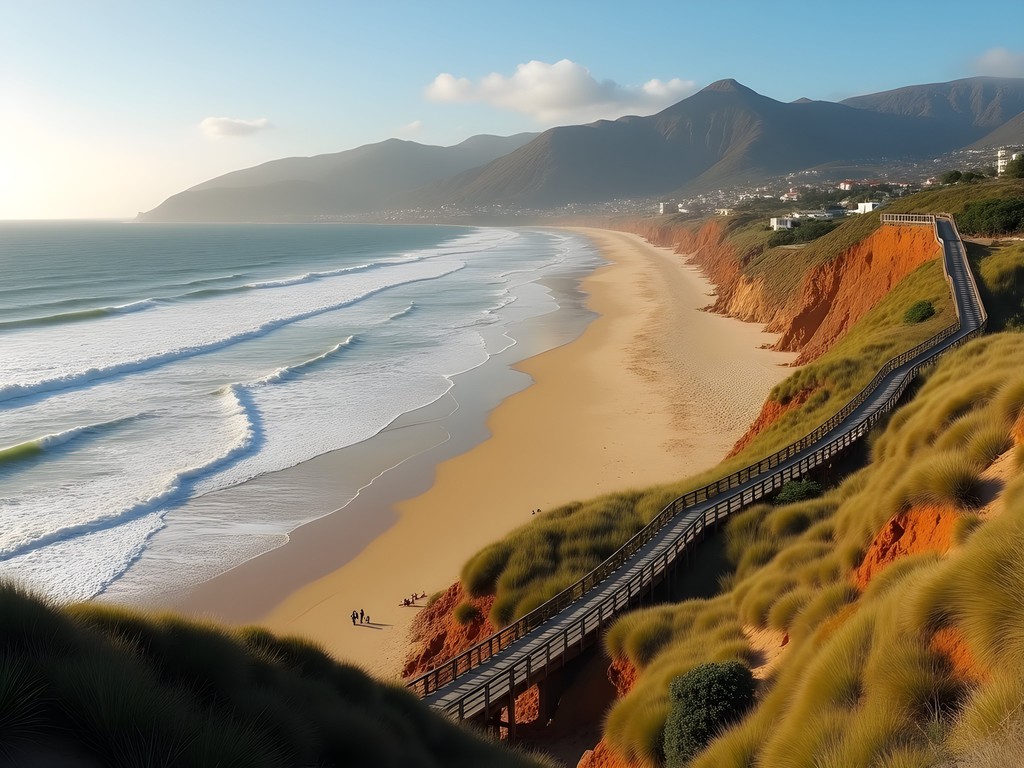
💡 Pro Tips
- Visit weekday mornings to avoid weekend crowds and afternoon winds
- The northern end of the beach tends to be less windy and better suited for families with young children
- Bring layers! Even in summer, the wind can make temperatures feel significantly cooler than in Lisbon
Praia de Carcavelos: Family-Friendly Waters with Urban Accessibility
Carcavelos represents the perfect compromise for families balancing beach desires with urban exploration. Positioned midway along the Lisbon-Cascais train line, this wide golden stretch offers the easiest access from the city center—just 20 minutes by train with minimal walking required from station to sand. During my comparative study of public spaces in European coastal cities, I spent several weeks observing how Carcavelos functions as a democratic social arena where Lisbon's diverse communities converge.
The beach itself spans nearly a mile, creating natural segmentation where different groups establish territory. Families typically gather near the central and eastern sections where gentle slope and seasonal lifeguard presence create safer swimming conditions. The western end near the imposing 16th-century São Julião da Barra Fort attracts a younger crowd and surf schools.
What makes Carcavelos particularly suitable for families is its infrastructure—clean public bathrooms, outdoor showers, wooden walkways, and a promenade lined with affordable restaurants serving fresh seafood. My insulated water bottle proved essential during long beach days here—the summer sun reflecting off sand can quickly dehydrate little ones.
Beyond swimming, Carcavelos offers rich opportunities for cultural observation. The beach hosts impromptu football matches where multi-generational family teams compete with good-natured intensity. Local vendors walking the shoreline sell traditional treats like bolas de berlim (custard-filled donuts)—a Portuguese beach tradition since the 1950s that connects contemporary beachgoers with previous generations who established these coastal rituals.
The 17th-century fort overlooking the western end provides historical context for older children. Though not always open for interior tours, its massive walls illustrate Portugal's historical need to defend its coastline—the same strategic position that made these beaches attractive for family recreation today makes them historically significant in Portugal's maritime defense system.
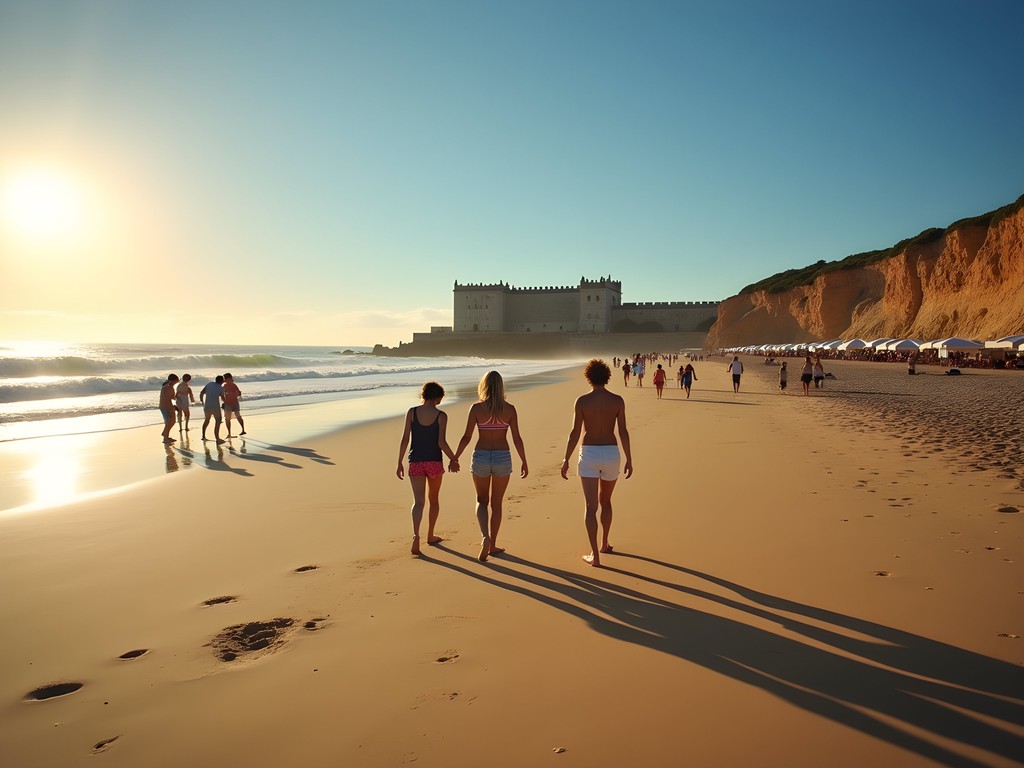
💡 Pro Tips
- Arrive early (before 10am) during summer months to secure a good spot before the beach fills
- Look for the blue flag designation that indicates water quality and safety monitoring
- Visit the small market near the train station before heading to the beach for affordable picnic supplies
Praia da Adraga: Hidden Gem for Natural Wonder
Some beaches demand more effort but reward visitors with transcendent beauty. Praia da Adraga, nestled between towering cliffs on the western edge of Sintra-Cascais Natural Park, is precisely such a place. Reaching this hidden cove requires navigating narrow roads through the Sintra hills or hiking coastal trails—a journey that filters out casual tourists but proves entirely worthwhile for families seeking natural wonder.
During my documentation of changing coastal access patterns in protected European landscapes, I spent three days observing Adraga's unique visitor dynamics. Unlike Lisbon's more accessible beaches, families who make the journey here tend to stay longer, explore more thoroughly, and engage more deeply with the environment.
The beach itself feels like nature's sculpture garden—dramatic rock formations create natural arches and tidal pools that become fascinating aquatic laboratories at low tide. Children instinctively transform into marine biologists, crouching beside pools to observe tiny crabs, anemones, and translucent shrimp. I recommend bringing a waterproof phone case to capture these discoveries without worrying about water damage.
What fascinates me as an anthropologist is how Adraga's relative isolation preserves traditional coastal practices. The small restaurant perched above the beach still serves caldeirada (Portuguese fish stew) made according to recipes passed through generations of fishing families. The ingredients come from the same waters visible from your table—a direct farm-to-table connection that predates the concept by centuries.
For families with older children, the trail connecting Adraga to nearby Praia do Magoito offers a magnificent coastal hike with opportunities to discuss erosion patterns, maritime vegetation, and human adaptation to challenging environments. Along the path, you'll notice small stone shelters built by fishermen who harvest percebes (goose barnacles)—a dangerous tradition where knowledge of tides, waves, and cliff access points represents crucial intergenerational wisdom.

💡 Pro Tips
- Check tide tables before visiting—low tide reveals the most interesting rock formations and tidal pools
- The restaurant above the beach often has long waits in summer; bring snacks as backup
- The narrow access road has limited parking; arrive before 11am or after 3pm for better chances
Portinho da Arrábida: Turquoise Waters in a Protected Reserve
The first time I glimpsed Portinho da Arrábida's impossibly blue-green waters, I genuinely questioned whether I was still in Portugal or had somehow been teleported to the Mediterranean. Nestled within Arrábida Natural Park about an hour south of Lisbon, this series of small beaches represents the most visually stunning coastal landscape in the region—and remains surprisingly uncrowded compared to its beauty.
Reaching Portinho requires either a car or a combination of public transport and walking, with the final descent revealing breathtaking panoramas of the Sado Estuary where the turquoise shallows gradually blend into deeper blue waters. The extra effort filters out mass tourism and helps preserve both the natural environment and the area's distinctive cultural character.
For families, Portinho offers unparalleled water experiences. The sheltered position within the bay creates calm, crystal-clear conditions perfect for children's first snorkeling adventures. The gradual depth increase allows comfortable wading far from shore, and the underwater visibility reveals an abundance of marine life that thrives in this protected marine reserve. I never visit without my snorkel set which has introduced countless children to the underwater wonders here.
What makes Arrábida particularly significant from a cultural perspective is its history as a boundary zone between inland agricultural traditions and maritime practices. The small fishing community here developed distinctive boat designs optimized for the unique conditions of this sheltered coastline. During summer evenings, you can sometimes witness demonstrations of traditional rowing techniques that have remained unchanged for generations.
The 17th-century fort (Forte de Santa Maria da Arrábida) overlooking the main beach houses a small but fascinating museum focused on marine biology and conservation. Taking children here before beach time helps contextualize the importance of the protected waters they'll be enjoying—creating young advocates for marine preservation while they play.
Despite its natural splendor, Portinho maintains a refreshingly unpretentious atmosphere. The handful of restaurants serve catch-of-the-day fish grilled simply with olive oil and lemon—a reminder that sometimes cultural authenticity comes through what hasn't changed rather than what has been innovated.
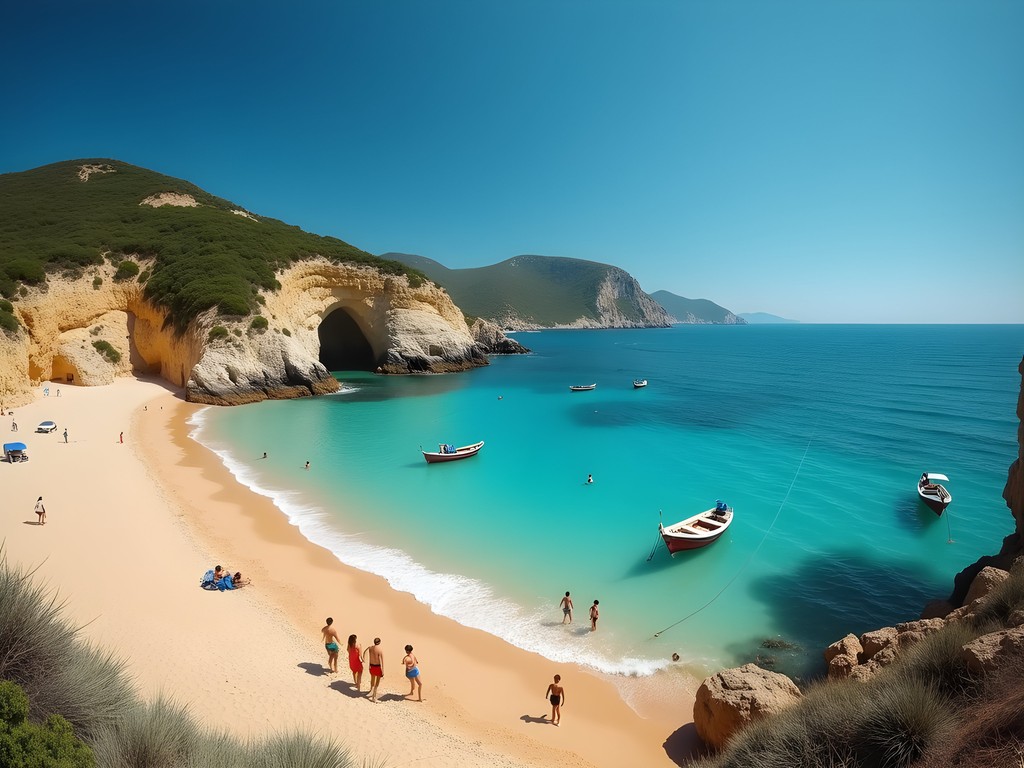
💡 Pro Tips
- Visit on weekdays if possible—weekend traffic can create significant delays on the narrow access roads
- Bring reef-safe sunscreen as the clear water reflects and intensifies the sun's rays
- Pack a picnic and plenty of water as the beach services are limited compared to more developed areas
Praia das Maçãs: Where Ocean Meets River for Perfect Family Balance
Named for the apples that once floated downriver to the sea after autumn storms, Praia das Maçãs offers a fascinating geographical convergence where the Colares River meets the Atlantic. This natural feature creates a unique beach environment particularly well-suited for families with children of different ages and swimming abilities.
During my documentation of seasonal community transitions in Portuguese coastal towns, I spent several weeks observing how this beach transforms from a quiet local spot in winter to a vibrant family destination in summer. The historic tram connecting Sintra to Praia das Maçãs represents more than convenient transport—it's a cultural lifeline that has maintained connections between inland and coastal communities since 1904.
For families, the beach's main appeal lies in its dual water environments. The ocean side offers traditional beach experiences with moderate waves suitable for beginner boogie-boarding and supervised swimming. Meanwhile, the river mouth creates a natural shallow pool where even toddlers can splash safely while watching small fish dart through the clear water. This natural division allows family members of different ages to enjoy water activities appropriate to their comfort levels while remaining within sight of each other.
The surrounding community preserves elements of traditional Portuguese coastal life that have disappeared from more developed areas. The small market near the beach still features local women selling handmade doilies and lace—coastal crafts developed during long winters when fishing was impossible. These textile traditions connect directly to my research interests and reveal how maritime communities developed parallel creative practices to supplement fishing incomes.
The beachside playground with its distinctive ocean-themed equipment provides a welcome alternative when children need a break from sand and sun. Nearby, several restaurants serve authentic Portuguese cuisine at reasonable prices—the seafood rice at Restaurante Neptuno offers a perfect introduction to local flavors for families ready to venture beyond standard tourist fare.
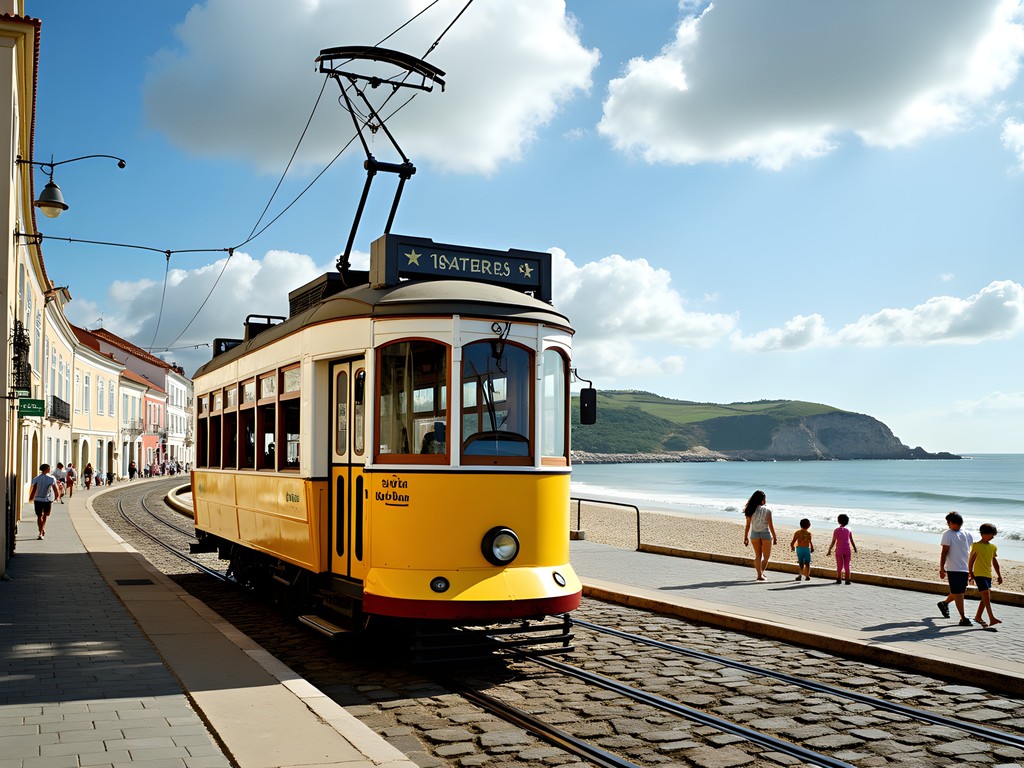
💡 Pro Tips
- Take the historic tram from Sintra for a scenic journey that children will love—it runs hourly during summer months
- Visit the small waterpark adjacent to the beach for a freshwater alternative when children tire of sand
- The afternoon wind typically picks up around 2pm—morning offers calmer conditions for younger children
Final Thoughts
As our coastal journey around Lisbon concludes, I'm struck by how these seven beaches collectively tell a story of Portugal's relationship with the Atlantic—from the protected coves where children take their first swimming lessons to the dramatic cliffs where fishermen still risk their lives harvesting percebes. What makes this coastline special for families isn't just the quality of sand or clarity of water, but the living heritage that continues to evolve along these shores. By venturing beyond Lisbon's urban attractions to these accessible coastal escapes, you're not just finding places to swim—you're experiencing environments that shaped Portuguese identity through centuries of maritime connection. Whether you choose the urban convenience of Carcavelos, the natural wonder of Arrábida, or the cultural richness of Cascais, these beaches offer children something increasingly rare: direct engagement with landscapes where human history and natural processes remain visibly intertwined. I hope your family creates memories along this coastline that deepen your understanding of how geography shapes culture—and perhaps inspires a lifelong curiosity about the communities that call these shores home.
✨ Key Takeaways
- Most beaches are easily accessible via public transportation, making car rental unnecessary for a beach-focused family vacation
- Visiting beaches at different times of day reveals distinct cultural patterns—morning fishermen, midday family gatherings, evening promenades
- The geological diversity within a small radius offers natural science lessons from tidal pools to dune ecosystems
- Portuguese beach etiquette is relaxed but appreciates respect for local customs—particularly regarding appropriate swimwear and noise levels
📋 Practical Information
Best Time to Visit
June to early September, with July and August being warmest but most crowded
Budget Estimate
€50-100 daily for a family of four including transport, meals and activities
Recommended Duration
5-7 days to explore multiple beaches without rushing
Difficulty Level
Easy - Most Beaches Have Good Facilities And Are Accessible By Public Transport

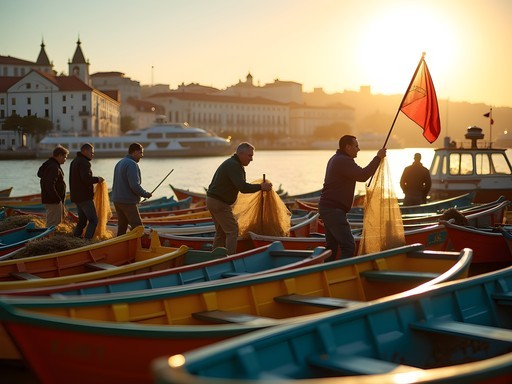
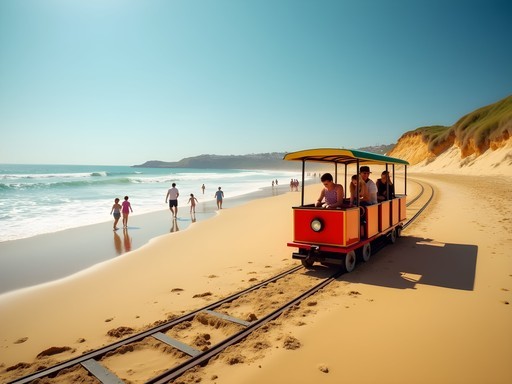
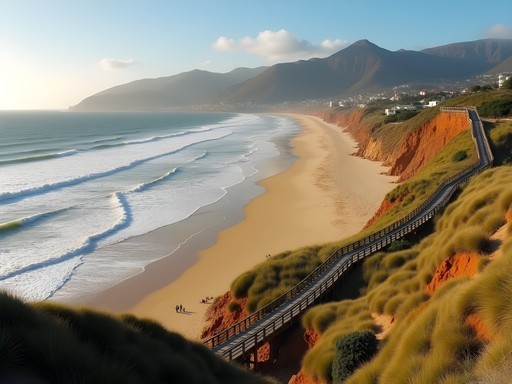
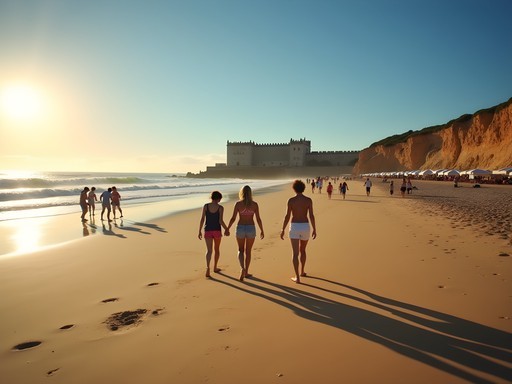

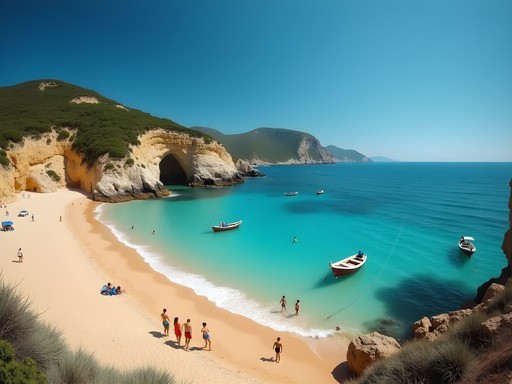



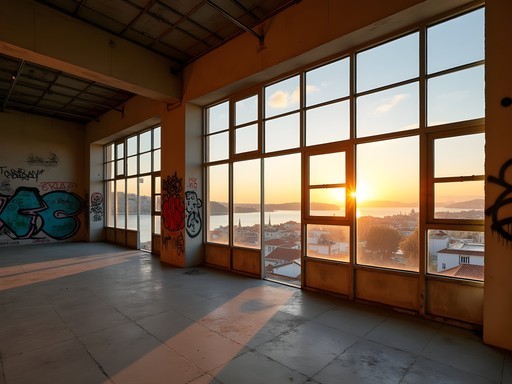
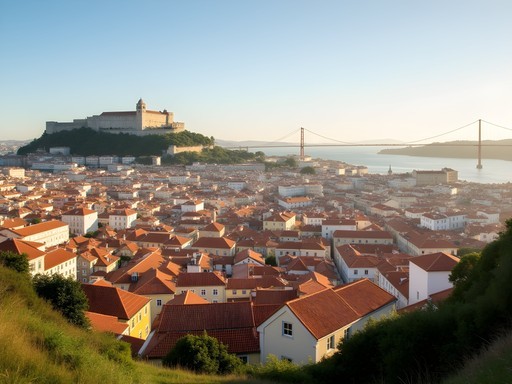
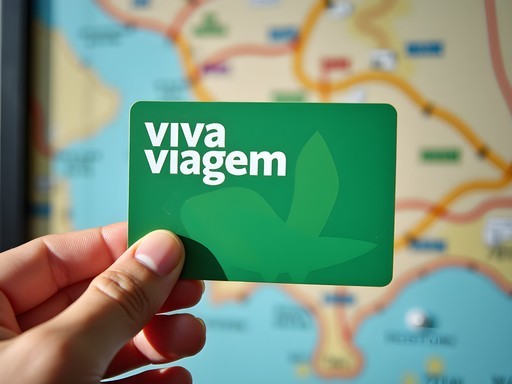


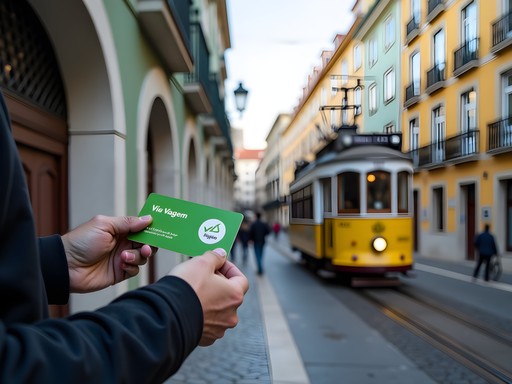

Comments
Savannah Walker
Claire, this is such a comprehensive guide! I spent a month in Lisbon last summer and completely fell for Costa da Caparica. The local bus from Cacilhas was super easy and cheap. For anyone heading there with kids, the northern beaches are calmer, while the southern stretches offer more seclusion. I actually met a local fisherman who still uses traditional nets - he showed me how they've been made the same way for generations. And don't miss the seafood at the beachfront restaurants - the grilled dourada is life-changing! I tracked all my beach adventures with my waterproof journal which was perfect for sandy fingers and unexpected splashes.
bluechamp
How crowded was Costa da Caparica in summer? Thinking of going in August.
Savannah Walker
It gets busy in August, especially on weekends! If you go, head to the beaches further south (past the first 5-6 beach bars). The extra 10 minute walk thins out the crowds dramatically.
travelphotographer5126
Those sunset shots of Praia do Guincho are incredible! Adding this to my bucket list immediately!
springlife
Just got back from Lisbon last week and wish I'd seen this post before! We only made it to Cascais but it was absolutely gorgeous. The train ride along the coast was half the fun - those views! Definitely going back next year to check out Praia do Guincho. Anyone been there in October? Wondering if it's too windy that time of year.
Amit Sullivan
October at Guincho is actually prime time for windsurfing because of those Atlantic breezes! If you're not into water sports, morning visits are calmer. The light is magical for photography too.
springlife
Thanks Amit! Not a windsurfer but definitely a photography enthusiast. Morning visit it is!
wanderingsouls
Great post! How are these beaches in April? Planning a spring trip.
claire_spencer
April can be hit or miss weather-wise, but you'll have the beaches mostly to yourself! Cascais and Carcavelos are good options as they have cafes and facilities open year-round. The water will be quite cold though!
Taylor Moreau
Excellent overview, Claire. I've been to Lisbon numerous times for business and can confirm that Costa da Caparica is perfect for families. The beach stretches for miles and the restaurants along the boardwalk serve fantastic grilled fish at reasonable prices. One tip for visitors: the buses from Lisbon can get quite crowded in summer, so consider taking an Uber or renting a car if you're traveling with children or beach equipment. I always bring my quick-dry towel which packs small and dries quickly between beach visits. The sunset views from Guincho are also spectacular if you can stay late enough.
beachlover22
We did the public transportation to Costa da Caparica last year and it was actually pretty good! Just avoid rush hour.
Taylor Moreau
Good point about timing! I usually travel during peak season which might explain my experience with crowded buses.
nomadguy
Just what I needed! Heading to Lisbon next month and definitely adding Cascais to my list now.
Taylor Moreau
Cascais is a gem! Don't miss the seafood restaurants near the marina. I was there on business last year and extended my stay just to enjoy the beaches.
nomadguy
Thanks for the tip! Any specific restaurant recommendations?
Taylor Moreau
Try Marisco na Praça if you can get a reservation. The grilled sea bass is exceptional.
dreamwanderer
Just got back from Portugal and used this guide extensively! We stayed in Lisbon for a week and visited Praia do Guincho and Carcavelos. The public transportation was so easy to use - just get a Viva Viagem card and load it up. Guincho was exactly as described - wild and windy, perfect for watching the surfers (though too rough for us to swim). The restaurant you recommended near Guincho was fantastic - we had the freshest grilled fish I've ever tasted. Carcavelos was much calmer and better for actually swimming. One thing to add - the sunset at Guincho was absolutely spectacular, worth staying late for! Thanks for this guide, it really made our trip special.
starmood
OMG these beaches look INCREDIBLE!!! 😍 Is it safe to leave belongings on the beach while swimming? Also what's the best time of year to go?
dreamwanderer
I went in September last year and it was perfect - still warm but fewer tourists. I used my anti-theft beach bag and had no issues leaving stuff while swimming. The locals were super friendly!
Ana Robinson
Claire, this is such a comprehensive guide! I visited Lisbon last summer with my two kids and we made it to three of these beaches. Cascais was our absolute favorite - we took the train from Cais do Sodré station which was an experience itself with those gorgeous coastal views! The kids loved watching the fishing boats come in while I appreciated those beautiful blue azulejos everywhere. We packed our lunch but ended up buying fresh seafood from the market instead. One tip for families: the tide pools at low tide were perfect for smaller children who weren't ready for the waves. I always recommend people stay in Lisbon but plan at least 2-3 beach days into their itinerary.
starmood
The train ride looks AMAZING in your photos!! Were the beaches crowded when you went?
Ana Robinson
We went in June and Cascais was busy but not overwhelming. Costa da Caparica had much more space to spread out! I'd avoid August if you don't like crowds though.
moonninja
This is perfect timing! Heading to Lisbon next month and had no idea there were so many beach options nearby.
Ana Robinson
You're going to love it! Make sure to try Praia de Carcavelos if you're traveling with kids. Super easy to reach by train from Lisbon center.
moonninja
Thanks for the tip! We're bringing our 5-year-old so that's perfect.
Venture X
Premium card with 2X miles, $300 travel credit, Priority Pass